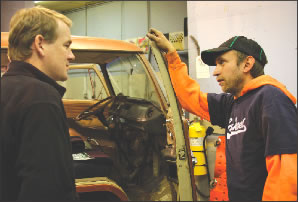by Hal Walter
“Some of them live, and some of them die.”
“If you don’t want to lose any, then don’t have any.”
“At least you don’t have to feed the sumbitch anymore.”
I’d nearly given up on the cow I call “Number 30.’ During the days running up to the March full moon her udder had been swelling, and I thought for sure the calf would arrive then. Some cattlepeople say that cows tend to have calves during foul weather, but a small snowstorm passed over, then a few more days, and the calf had yet to be born.
Due to a change in the business plan for our natural grassfed beef business — basically we lost our low-elevation winter pasture — we sold most of the cattle last fall. We kept only five cows and our red Angus bull, and even that proved to be a hardship in terms of the feed bill and keeping them in water during the most frigid months. We have to buy and transport all our hay, and since there’s no reliable running water on the place in January and February it’s hoses and electric tank heaters.
I knew that one of our five cows was not pregnant. The vet said there was a minor epidemic of this in our area, perhaps due to a late, cold spring last year. Whatever. It left us with only four calves on the way.
Ranchers who keep hundreds of cows count on a certain percentage of loss. It’s just part of the cost of doing business. But it doesn’t take a mathematician to determine that for a microranch like the one I manage losing even one animal is a devastatingly high percentage.
Another warm spell arrived before the spring equinox and I began to think maybe Number 30 was just “bagging up” early. But then one day I found the cow off by herself in a group of trees, and what appeared to be a dandy little calf with her.
Over the next few days I kept a close eye on this calf to make sure it seemed healthy. Everything seemed fine, but oddly this cow had a habit of leaving the calf by itself. Once neighbors called and I found the calf lying in the right-of-way of the main county road, about a half-mile from the mother cow who was munching hay at the feeder. Another time the calf was sleeping along the ranch driveway. Both times I managed to get the little calf back to the cow, who seemed pretty nonchalant about motherhood in general. This was puzzling as this was one of our original cows and she had raised at least three other fine calves with no problems. But oftentimes animals know more than we do and I began to wonder if there might be something wrong with this calf.
This time of year a warm spell often comes just before a big storm. These wet spring snowstorms are our most important source of moisture here in the Wet Mountains. But for as much life as these storms can bring, they can also be deadly.
I keep my eye on the Weather Channel and NOAA’s website and knew that a big system was heading into the area packing 16 to 28 inches of snow. After a storm in 2003 left seven feet and stranded us here for days, I learned to prepare for the worst. Over at the ranch, we feed both the horses and cattle with 1,200-pound round bales that I set out in feeders with a tractor. This works out great most of the time, but our tractor is a older model two-wheel-drive, and it pays to be careful and time your feedings so you don’t run low right before a big storm.
I checked the cattle hay feeder and saw it was less than half full, probably enough for two more days, but maybe not. There’s an arena in the pasture where the cattle are, so I put a big round bale inside the arena and closed the gate. If the cattle ran out of hay in their feeder during the storm, I was prepared to open the arena and cut the strings on this bale.
There also are eight horses at the ranch. They had a significant amount of a round bale left, but I decided to put out another one just in case.
We rely on wells and electric pumps to provide winter water to the livestock. If the power goes out, as it sometimes does during heavy, wet storms, this can be a problem. So I topped off all water tanks to have 170 gallons on hand for the horses, and 350 gallons for the cattle. Back at home I made similar preparations for my burros, though it’s much simpler to fill two 70-gallon tanks and set a small square bale of hay out by the fence not far from my front door.
I was now ready for the storm and to celebrate I headed out into the wind. Shortly before being blinded by the first squalls of snow, I saw something most people probably never will — two red-tailed hawks mating in an aspen tree.
The storm brought only ten inches of snow, but it had considerable water content of about one inch. I marveled at the resilency of livestock animals to withstand weather that would send humans into hypothermia. Especially amazing was the idea that something about ten days old could survive, but there she was, standing with the older cows like it was nothing out of the ordinary.
Then three days later a small but wicked storm blew through with little new snow, but the accompanying high wind whipped up a vicious ground blizzard.
When I found the calf afterward she was covered in light, windblown snow and I thought she was dead. As I was walking away I saw a twitch and realized she actually was still alive.
I moved the calf to the barn on a sled. I recruited my neighbor Patti to help, and we rounded up the mother cow and put her in the paddock with her calf. We managed to feed the calf some warmed-up goat milk that I had in my refrigerator using a plastic bottle and an improvised nipple made from the finger of a rubber glove. As we dribbled the milk down the calf’s throat I had little hope that she would survive, but decided that I had to give it my best try. I rigged up a heat lamp in a covered corner of the paddock and put down wood chips for bedding.
I consulted both veterinarians we use at the ranch, and although the prognosis was poor, between them came up with a regimen of medications, injected vitamins, and feedings using an esophogeal tube and bag. After three days of these feedings, the calf was still unable to stand for very long on its own, and too weak to suckle. Several times I tried standing the calf next to the cow but with the slightest bump from its mother the calf’s legs would buckle and she’d fall down. The situation was so pathetic that I wondered if I was even doing the right thing trying to keep this calf alive.
Then on the fourth day the calf died.
I looked at the little form in the wood chips, then looked out on the snowy, frozen April landscape with its pinkish-orange evening light glowing around the edges. “Damn,” I whispered.
I’m sure it’s not the first time someone who raises livestock has expressed such a profound sense of futility over the realities of ranching. And I’m sure it would not be the last.
• • •
Word came in late March that Neal Hart passed away at the age of 84. Neal, the father of fellow pack-burro racer Steve Hart, has for years headed up the Ham radio team that keeps track of runners and their burros on the courses at the Leadville, Fairplay and Buena Vista races. His face was always a welcome and reassuring sight when I would see him on Mosquito Pass along with his faded-orange International Scout with the antennae for his radio equipment. I can still hear him — and it could be in a lightning storm, fog, blowing snow or hail, on a hot sunny day, or through a hypoxic haze. It didn’t matter whether I was winning or off the back. He would always ask: “You need anything, Hal?” Neal always struck me as a kind and gentle man. I know he will be greatly missed by all who knew him.
Hal Walter writes and edits from the Wet Mountains. You can keep up with him regularly at his blog: www.hardscrabbletimes.wordpress.com

